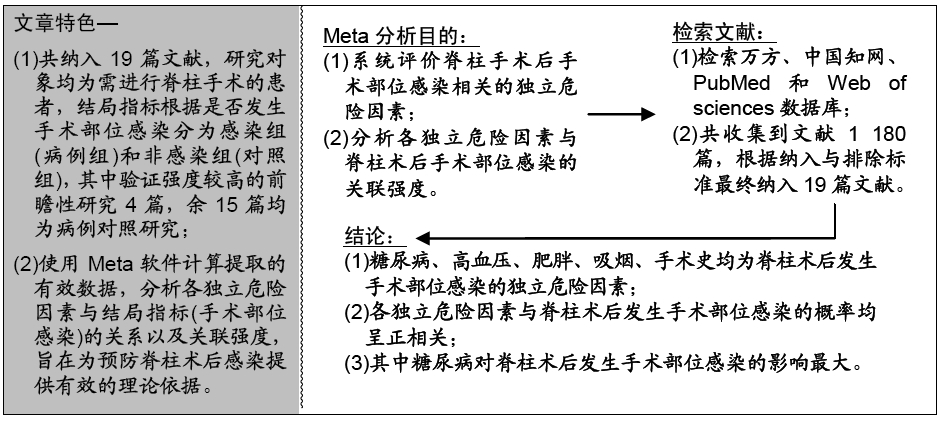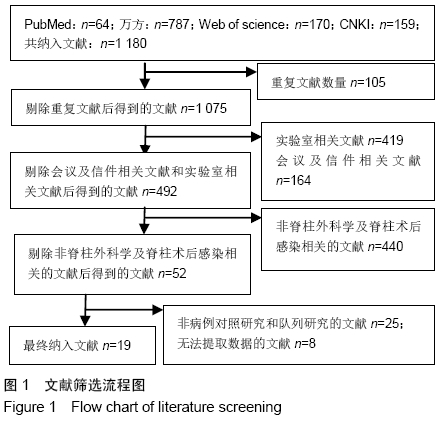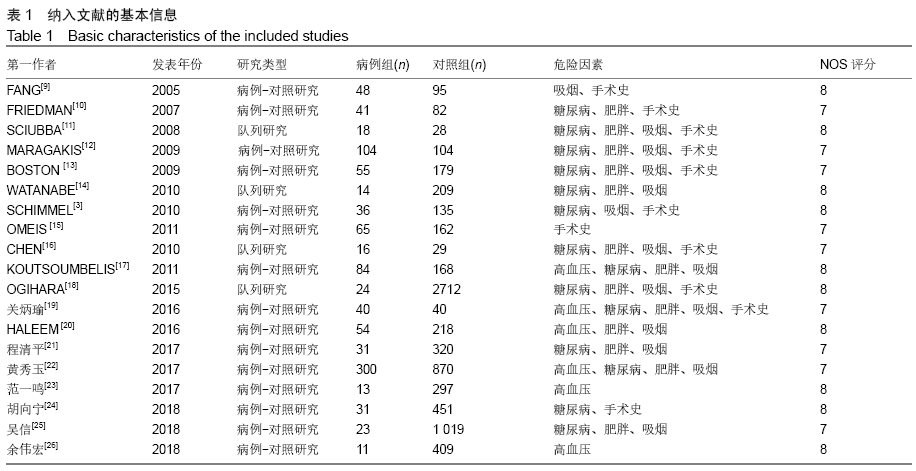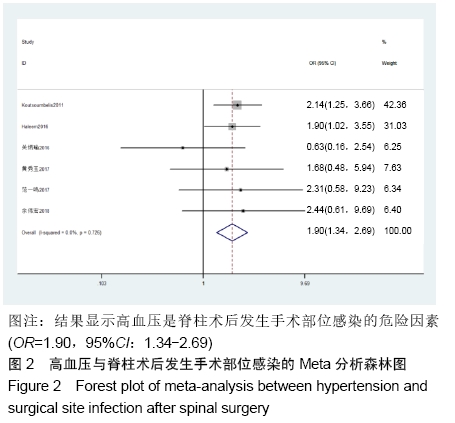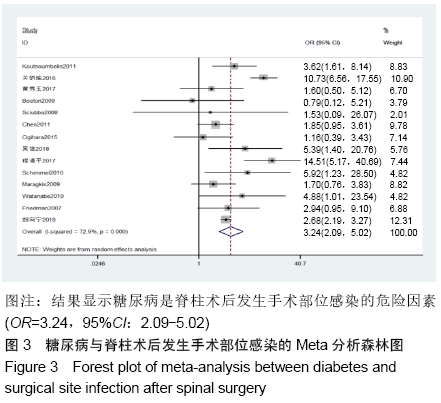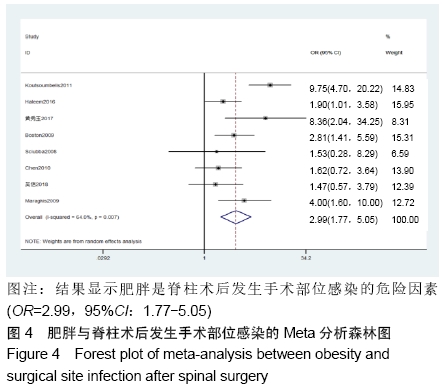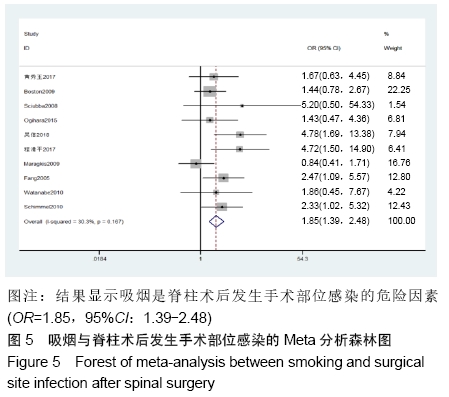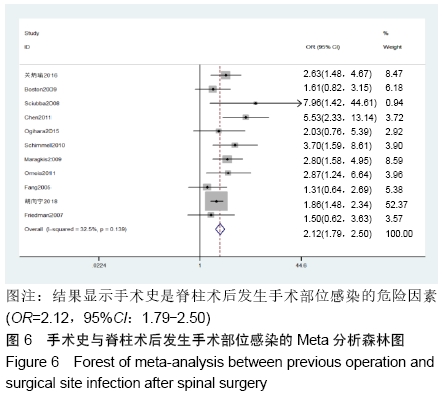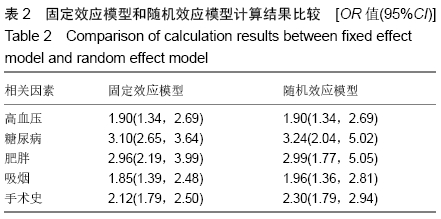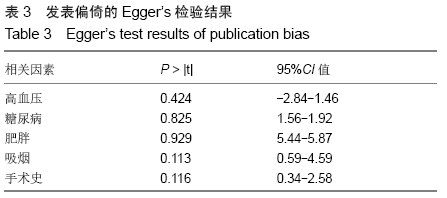[1] 张淑娟. 2018年我院普外科医院感染现患率调查及因素分析[J]. 基层医学论坛,2019,23(27): 3967.
[2] 王铮,曹华,徐正,等.腰椎术后切口感染病原菌及耐药性分析[J]. 中华医院感染学杂志,2019,29(5):734-736.
[3] SCHIMMEL JJ, HORSTING PP, DE KLEUVER M, et al. Risk factors for deep surgical site infections after spinal fusion. Eur Spine J. 2010;19(10):1711-719.
[4] 中国高血压防治指南修订委员会,高血压联盟(中国中华医学会心血管病学分会,中国医师协会高血压专业委员会,中国医疗保健国际交流促进会高血压分会,中国老年医学学会高血压分会.中国高血压防治指南(2018年修订版)[J].中国心血管杂志,2019, 24(1):24-56.
[5] 中华医学会糖尿病分会.中国2型糖尿病防治指南(2017年版) [J]. 中国实用内科杂志,2018,38(4): 292-344.
[6] OGDEN CL, YANOVSKI SZ, CARROLL MD, et al. The epidemiology of obesity. Gastroenterology. 2007;132(6): 2087-2102.
[7] KONG L, LIU Z, MENG F, et al. Smoking and risk of surgical site infection after spinal surgery: a systematic review and meta-analysis. Surg Infect (Larchmt). 2017;18(2): 206-214.
[8] MANGRAM AJ, HORAN TC, PEARSON ML, et al. Guideline for prevention of surgical site infection, 1999. Hospital Infection Control Practices Advisory Committee. Infect Control Hosp Epidemiol. 1999;20(4): 250-278; quiz 279-280.
[9] FANG A, HU SS, ENDRES N, et al. Risk factors for infection after spinal surgery. Spine. 2005;30(12):1460-1465.
[10] FRIEDMAN ND, SEXTON DJ, CONNELLY SM, et al. Risk factors for surgical site infection complicating laminectomy. Infect Control Hosp Epidemiol. 2007;28(9):1060-1065.
[11] SCIUBBA DM, NELSON C, GOK B, et al. Evaluation of factors associated with postoperative infection following sacral tumor resection. J Neurosurg Spine. 2008;9(6): 593-599.
[12] MARAGAKIS LL, COSGROVE SE, MARTINEZ EA, et al. Intraoperative fraction of inspired oxygen is a modifiable risk factor for surgical site infection after spinal surgery. Anesthesiology. 2009; 110(3):556-562.
[13] BOSTON KM, BARANIUK S, O'HERON S, et al. Risk factors for spinal surgical site infection, houston, texas. Infect Control Hosp Epidemiol. 2009; 30(9): 884-889.
[14] WATANABE M1, SAKAI D, MATSUYAMA D, et al. Risk factors for surgical site infection following spine surgery: efficacy of intraoperative saline irrigation. J Neurosurg Spine. 2010;12(5):540-546.
[15] OMEIS IA, DHIR M, SCIUBBA DM, et al. Postoperative surgical site infections in patients undergoing spinal tumor surgery: incidence and risk factors. Spine (Philadelphia, 1976). 2011; 36(17):1410-1419.
[16] CHEN KW, YANG HL, LU J, et al. Risk factors for postoperative wound infections of sacral chordoma after surgical excision. J Spinal Disord Tech. 2011;24(4):230-234.
[17] KOUTSOUMBELIS S, HUGHES AP, GIRARDI FP, et al. Risk factors for postoperative infection following posterior lumbar instrumented arthrodesis. J Bone Joint Surg Am. 2011; 93A(17):1627-1633.
[18] OGIHARA S, YAMAZAKI T, MARUYAMA T, et al. Prospective multicenter surveillance and risk factor analysis of deep surgical site infection after posterior thoracic and/or lumbar spinal surgery in adults. J Orthop Sci. 2015; 20(1): 71-77.
[19] 关炳瑜,阿海,贺元,等.脊柱外科术后感染的影响因素分析[J]. 临床骨科杂志,2016,19(5): 547-549.
[20] HALEEM A, CHIANG HY, VODELA R, et al. Risk factors for surgical site infections following adult spine operations. Infect Control Hosp Epidemiol. 2016;37(12):1458-1467.
[21] 程清平,王东福,焦朋,等.腰椎间盘突出症术后椎间隙感染的治疗及危险因素分析[J].中国骨与关节损伤杂志,2017,32(1):32-35.
[22] 黄秀玉.脊柱后路术后感染危险因素分析[J].中国医药导报,2017, 14(22):72-75.
[23] 范一鸣,王征,王岩.腰椎后路内固定术后早期切口深部感染的相关因素分析[J].颈腰痛杂志,2017,38(4):327-330.
[24] 胡向宁,周秦,穆玲娟,等.脊柱手术后发生切口感染的相关因素分析及预防措施[J].临床医学研究与实践,2018,3(20):50-51.
[25] 吴信,尚显文,张皓,等.脊柱内固定术后手术部位感染的原因分析及防治措施探究[J].实用骨科杂志,2018,24(1): 10-14.
[26] 余伟宏,冯永洪,王新强,等.腰椎后路术后手术切口早期感染的危险因素分析[J].海南医学,2018,29(15):2175-2177.
[27] MALONE DL, GENUIT T, TRACY JK, et al. Surgical site infections: Reanalysis of risk factors. J Surg Res. 2002;103(1): 89-95.
[28] NEUMAYER L, HOSOKAWA P, ITANI K, et al. Multivariable predictors of postoperative surgical site infection after general and vascular surgery: results from the patient safety in surgery study. J Am Coll Surg. 2007;204(6):1178-1187.
[29] SHILLING AM, RAPHAEL J. Diabetes, hyperglycemia, and infections. Best Pract Res Clin Anaesthesiol. 2008; 22(3): 519-535.
[30] VERHOFSTAD MH, HENDRIKS T. Complete prevention of impaired anastomotic healing in diabetic rats requires preoperative blood glucose control. Br J Surg. 1996;83(12): 1717-1721.
[31] VAN DEN BERGHE G, WOUTERS P, WEEKERS F, et al. Intensive insulin therapy in the critically ill patients. N Eng J Med. 2001;345(19):1359-1367.
[32] 黄文娟,王成,旭思哲,等.学龄期儿童高血压和肥胖发病率调查[J]. 国际儿科学杂志,2017,44(4):294-296.
[33] PULL TER GUNNE AF, COHEN DB. Incidence, prevalence, and analysis of risk factors for surgical site infection following adult spinal surgery. Spine (Phila Pa 1976). 2009;34(13): 1422-1428.
[34] WISSE BE. The inflammatory syndrome: the role of adipose tissue cytokines in metabolic disorders linked to obesity. J Am Soc Nephrol. 2004;15(11):2792-2800.
[35] SERNÉ EH, GANS RO, TER MAATEN JC, et al. Impaired skin capillary recruitment in essential hypertension is caused by both functional and structural capillary rarefaction. Hypertension. 2001; 38(2):238-242.
[36] WEBER MA, SCHIFFRIN EL, WHITE WB, et al. Clinical practice guidelines for the management of hypertension in the community: a statement by the American Society of Hypertension and the International Society of Hypertension. J Clin Hypertens (Greenwich). 2014;16(1):14-26.
[37] WRIGHT JT JR, FINE LJ, LACKLAND DT, et al. Evidence supporting a systolic blood pressure goal of less than 150 mm Hg in patients aged 60 years or older: the minority view. Ann Intern Med. 2014;160(7):499-503.
[38] 李军.围术期高血压管理专家共识[J].临床麻醉学杂志,2016, 32(3): 295-297.
[39] 李瑶宣,李吕力.超声检测肱动脉内皮功能的研究进展[J].医学综述,2009,15(4): 585-587.
[40] 陈桂英,郭来敬,廖燕华,等.吸烟与脉搏波传导速度、踝臂指数以及颈动脉硬化改变的相关性研究[J].现代中西医结合杂志,2013, 22(35): 3883-3885.
[41] YAMAGUCHI Y, HAGINAKA J, MORIMOTO S, et al. Facilitated nitration and oxidation of LDL in cigarette smokers. Eur J Clin Invest. 2005;35(3):186-193.
[42] MCEVOY JW, NASIR K, DEFILIPPIS AP, et al. Relationship of cigarette smoking with inflammation and subclinical vascular disease: the Multi-Ethnic Study of Atherosclerosis. Arterioscler Thromb Vasc Biol. 2015;35(4):1002-1010.
[43] XING D, MA JX, MA XL, et al. A methodological, systematic review of evidence-based independent risk factors for surgical site infections after spinal surgery. Eur Spine J. 2013;22(3): 605-615
[44] OLSEN MA, MAYFIELD J, LAURYSSEN C, et al. Risk factors for surgical site infection in spinal surgery. J Neurosurg. 2003; 98(2 Suppl):149-155.
[45] 吴信.脊柱内固定术后手术部位感染的原因分析及治疗措施探究[J].贵阳:贵州医科大学, 2016.
[46] 刘晓芳.尼古丁依赖的药物治疗:指南与经验[J].临床药物治疗杂志, 2011, 9(6): 25-28.
[47] PENG XQ, SUN CG, FEI ZG, et al. Risk factors for surgical site infection after spinal surgery: a systematic review and meta-analysis based on twenty-seven studies. World Neurosurg. 2019;123:e318-e329.
[48] SEBAALY A, SHEDID D, BOUBEZ G, et al. Surgical site infection in spinal metastasis: incidence and risk factors. Spine J. 2018; 18(8): 1382-1387.
[49] PESENTI S. Meta-analysis of risk factors associated with surgical site infection after spinal arthrodesis. Spine J. 2017.
|
